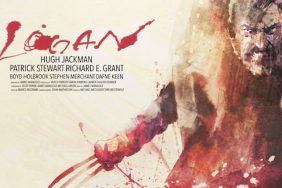At the root of every cliché, so the saying goes, is a grain of truth. One of the resilient cultural clichés is that of the tormented artist, one whose ghosts and demons drive his or her work, but also makes their life a living hell. Edvard Munch is a poster boy for that particular notion of the artist. His iconic painting, “The Scream,” is one of the most recognized works of visual art in the world partly because the existential anguish it captures not only puts forth Munch’s own interiority, but something of the human condition itself. It cements his status as both tortured artist and spokesman for the spiritually, psychically wounded.

Munch’s “Love and Pain (Vampire)”
Born into a middle-class Norwegian family in 1863, he was one of five children. His mother’s death from tuberculosis when he was five set off a family narrative defined by illness and madness, permanently scarring Munch and leaving him with the bleak worldview he’d eventually set to canvas.
One of the great strengths of the documentary The Post Impressionists: Munch is how commentators Carole Guberman and David Addison strike the right notes in their analysis of the artist’s work. Their balance of aesthetic critique, historicizing and contextualizing both art and artist within frameworks that acknowledge arts movements and specific artists that influenced him, and their respectful but candid insights on how his psychological and emotional issues all played out in his work, all give the viewer access to the motivations and processes behind the work. It’s informative but never dry or overly academic. The documentary is a brisk but substantive overview, perfect for novices unfamiliar with the artist beyond “The Scream.” Fans already schooled in Munch’s work and critical studies of it might find it light going.

Munch’s “The Dance of Life”
As the film unfolds and we’re taken through failed romances, alcoholism, nervous breakdowns, and friendships with a who’s who of European free-thinkers, artists and philosophers Munch associated with, a steady stream of his work fills the screen. His evolution as a craftsman (he was also a much respected and influential graphic artist) is mapped out against examples of the various artists and trends he embraced, siphoned what he needed, and moved on.
An especially rich segment notes how he became enthralled with the Impressionists after a trip to Paris, and from them he “took what he felt was useful to him in the matter of technique… his brush work became freer and more subtle.” But where the Impressionists were mostly drawn to light subject matter, Munch took their techniques and applied them to his obsessions with death, isolation and despair.

“The Scream”
Unintentionally reinforcing cliché and stereotype, the film’s resident experts note that after recuperating from a nervous breakdown in 1908, Munch’s subsequent work – with only intermittent exception – lost much of the intensity and power that defined his strongest and most important work. His work had been a kind of exorcism; his demons made the work possible. When they were quelled, the work itself became somewhat inferior. He lived another 35 years after recovering from the breakdown, dying in 1944 at the age of 80.
Below the full documentary is a specific look at one of his most ambitious projects, “Frieze of Life.”
Previously on Art Doc of the Week:
Art Doc of the Week
-
Art Doc of the Week | Los Punks: We Are All We Have

The award-winning doc looks at Los Angeles’ 40-year-old punk scene.
Photo: Angela Boatwright
-
Art Doc of the Week | McQueen and I

The late fashion designer Alexander McQueen’s life was as unconventional as his iconic shows.
Photo: Alexander McQueen: Savage Beauty
-
Art Doc of the Week | Who Is Poly Styrene?

The late British-Somali punk icon was vulnerable in her feminist art.
Image Courtesy the Artist Estate
-
Art Doc of the Week | Eva Hesse

The new documentary on the on the late visual artist is both informative and soulful.
Image Courtesy the Filmmaker
-
Art Doc of the Week | Packed in a Trunk

Edith Lake Wilkinson’s great niece investigates why the painter was institutionalized for seemingly no reason.
Photo: Wolfe Video
-
Art Doc of the Week | The Kate Bush Story

The 2014 BBC documentary on the reclusive pop star lets her high-profile fans swoon all over her.
Photo: Peter Mazel / Sunshine
-
Art Doc of the Week | Nikki Giovanni and Muhammad Ali in Conversation

The ionic poet interviews and is charmed by the sports legend for Soul talk show.
Photo: Getty Images
-
Art Doc of the Week | They Will Have to Kill Us First

Malian musicians use their music to stand up to Islamic fundamentalists.
Photo: BBC Worldwide
-
Art Doc of the Week | Step Up and Be Vocal

The 2001 film looks at the role punk played and plays in shaping some queer and feminist identities.
Photo: PansyDivision.com
-
Art Doc of the Week | Mapplethorpe: Look at the Pictures

The first ever documentary on Robert Mapplethorpe makes the case for his art and legacy while showing his warts and all.
Photo: J. Paul Getty Trust / LACMA / Robert Mapplethorpe Foundation
-
Art Doc of the Week | Parliament Funkadelic: One Nation Under A Groove

Director Yvonne Smith traces funk from its doo-wop origins to its role as a building-block of hip-hop.
Photo: GeorgeClinton.com
-
Art Doc of the Week | Pete Seeger: The Power of Song

An OG political protest singer has much to teach us today.
Photo: Reuters
-
Art Doc of the Week | The Post Impressionists: Munch

Edvard Munch was a poster boy for the idea of the artist as brilliant, immeasurably tortured soul.
-
Art Doc of the Week | Detroit, Vogue

Director Mollie Mills’s short doc on Detroit’s current ball culture is high on visual impact, skimpy on substance.
Photo: Vogue, Detroit
-
Art Doc of the Week | Colored Frames
 The paintings highlighted in Lerone D. Wilson’s film are pulled into deep conversation with the complex realities of black life.
The paintings highlighted in Lerone D. Wilson’s film are pulled into deep conversation with the complex realities of black life.Photo: Colored Frames
-
Art Doc of the Week | Spirits of Rebellion

Filmmaker Zeinabu Irene Davis’ documentary on filmmakers of the LA Rebellion is timely and illuminating.
Photo: Spirits of Rebellion / Julie Dash
-
Art Doc of the Week | Five

The 1971 documentary gives an overview of five African American visual artists as the bloody ‘60s turn into the hopeful ‘70s.
Photo: 110 St Harlem Blues, by Romare Bearden, courtesy DC Moore Gallery
-
Art Doc of the Week | Masters of Photography: Diane Arbus

This 1972 documentary filmed one year after the photographer’s suicide is intimate and revealing.
Top Photo: Roz Kelly / Getty Images
-
Art Doc of the Week | Dorothea Lange: An American Odyssey

The iconic photographer’s images of 20th century Depression-era America speak to current battles around class, race, immigration, and poverty.
Photo: Dorothea Lange
-
Art Doc of the Week | Out and Bad: London’s LGBT Dancehall Scene

The struggles and joys of forging queer identity within dancehall culture.
Photo: Dazed/Bernard Miller
-
Art Doc of the Week | And When I Die, I Won't Stay Dead

Director Billy Woodberry’s poetic take on the life and work of beat poet Bob Kaufman.
Photo: Billy Woodberry
-
Art Doc of the Week | The Sound of Redemption

Director N.C. Heikin turns saxophonist Frank Morgan’s life into one of 2015’s best documentaries.
-
Art Doc of the Week | It Came from Kuchar

The Bronx-raised Kuchar twins helped pioneer American underground film.
Photo: Indie Pix
-
Art Doc of the Week | Tamara de Lempicka

The visionary artist, an OG Material Girl, is still struggling to get art world respect.
Photo: http://www.delempicka.org/
-
Art Doc of the Week | Jaco

A documentary on the life and music of Jaco Pastorius also probes link between mental illness and creativity.
Photo: JacoPastorius.com
-
Art Doc of the Week | Janis Joplin: Little Girl Blue

A new documentary on the late rock icon digs beneath the lore to find a complex woman and artist.
Photo: Evening Standard/Getty Images
-
Art Doc of the Week | The Many Faces of Billie Holiday

Lady Day was much more than her blues, as this documentary makes clear.
Photo: The William P. Gottlieb Collection
-
Art Doc of the Week | Anita Sarko

The legendary DJ’s words on art, culture and creativity resonate powerfully in the wake of her recent death.
Photo: Svetlana Samoshina
-
Art Doc of the Week | Antonio Gaudi

Filmmaker Hiroshi Teshigahara lets out his inner fanboy as he pays tribute to his hero, iconic architect Antonio Gaudi.
Photo: The Criterion Collection
-
Art Doc of the Week | Poetry of Resilience

Katja Esson's documentary allows poets to reclaim the depth and possibilities of art.
Photo: Jeremy Sutton Hibbert








